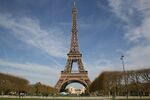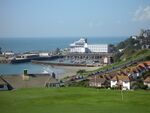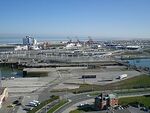Calais
“I was in prison for two years and it was still nicer than Calais.”
“At least it's not Folkestone.”
Calais is a small shanty town in Northern France comprised mainly of roads, street lights and cheap alcohol stores. It is also known for being the first place in France you come to from England, unless of course you travel to Boulogne or Dieppe or Le Havre or Caen or Cherbourg or Cyborg or Roscoff or St Malo or Dunkirk (or if you fly). Calais is notable in that it is a place that people like to leave; so much so that refugees from the Middle East are prepared to walk through the world's longest undersea tunnel (measuring 23.5 miles), which is filled with big metal machines travelling at incredibly fast speeds and big electrical currents that can kill, just to get away from Calais.
Calais was previously part of England, and it still is as a British supermarket chain recently invaded and has manifested itself there selling only booze. This makes a change because normally people can buy horse as well (or, as it is called in French, un cheval hâche). Calais is also known for the Calais Jungle, a squalid area that shelters journalists and politicians who are desperately trying to exploit the refugee crisis at Calais. Here, BBC News correspondents are seen trying to get emotional stories from refugees. The Channel Tunnel starts in Calais, and ends near more interesting places such as Hythe, Dover and The People's Democratic Republic of Folkestone.
History[edit]
Calais has its roots in the ground, or rather it would have its roots in the ground if there were any trees there. Instead, Calais is built out of a profusion of roads, which lend the town its appearance of a dystopian nightmare. This is due to the many ferries and trains that depart from Calais towards England's ports of Dover and Folkestone. Many tourists pass Calais on their way to more interesting and important things such as Paris, Lille, Brussels and Mickey Mouse, and the many roads help them to get away from Calais as quickly as possible.
The same, however, is not true of Folkestone, where there has been a settlement since the Mesolithic era, and which was inhabited during Roman Britain. A nunnery was founded by Eanswith, daughter of Æthelberht of Kent in the 7th century, who is still commemorated as part of the town's culture. During the 13th century it subsequently developed into a sea port and the harbour developed during the early 19th century to provide defence against a French invasion, and expanded further after the arrival of the railway in 1843, with four railway stations; at Folkestone Harbour, Folkestone East, Folkestone Central and Folkestone West. Only the latter two survive today.
Climate[edit]
The climate of Calais is relatively unknown as people never stay there long enough to tell; they just pass through in cars and trains without getting out.
Folkestone has a much more interesting climate, however, as in 2007 it suffered an earthquake. The earthquake's shallow depth and proximity to Folkestone resulted in structural damage in the town, and one woman suffered a minor head and neck injury. Following the earthquake, a total 474 properties were reported as damaged, with 73 properties too badly damaged for people to return to, 94 seriously damaged, and 307 suffering from minor structural damage. Harvey Grammar School situated in Cheriton Road, Folkestone was closed on 30 April due to "significant structural damage".
Several thousand homes were left without power for several hours and there were reports of a "smell of gas" in Folkestone. The Port of Dover, the channel tunnel and travel links were unaffected, although authorities asked people heading towards Dover to use the A2.
Today[edit]
Today, Calais is a busy place, though still not as important as Folkestone, which is connected by Stagecoach in East Kent bus routes 17, 101, 102, 10, 10A, 91, GOLD route 16 and National Express coaches to Dover, Canterbury, Ashford, Hastings, Hythe, Maidstone, the Romney Marsh, Gillingham, Hempstead Valley, Bluewater, London and places in Europe. The governance of Folkestone lies in both national and local government. Insofar as national government is concerned, Folkestone is part of the constituency of Folkestone and Hythe, which is currently (2016) represented by Damian Collins (Conservative). In the European Parliament, Folkestone is part of the South East England constituency, with ten MEPs.
Local government consists of three tiers. In the first tier, Kent County Council, Folkestone is divided into three Divisions each returning one County Councillor. Folkestone North East comprises Park, Foord and East wards and is represented by Cllr Richard Pascoe (Conservative). Folkestone South comprises Harvey West, Harvey Central and Harbour wards and is represented by Cllr Roland Tolputt (Conservative). Folkestone West comprises Cheriton and Morehall wards and neighbouring Sandgate Parish Council. It is represented by Cllr Tim Prater (Liberal Democrat).
The second tier of local government is the non-metropolitan district. Folkestone forms a part of Shepway District, which was established by the Local Government Act 1972. Folkestone elects 18 of Shepway District Council's 46 Councillors, who currently sit as 16 Conservatives and two People First. The next election is due to be held in May 2015.
The third and lowest tier was established as the civil parish: in Folkestone’s case, because it held a Town Charter, and when the then Folkestone Borough Council was abolished, Councillors elected to represent Folkestone's wards were designated as the Town's Charter Trustees, responsible for electing a Town Mayor. This role has since passed to Folkestone Town Council.
Folkestone Town Council was established in 2004, comprising the area of the former Borough of Folkestone less Folkestone Sandgate ward, which was separately parished. Folkestone Town Council comprises eight wards: Cheriton; Kent; Morehall; Park; Harvey West; Harvey Central; Harbour; East; and Foord. Each ward returns two or three members, for a total of 18 Councillors elected to four year terms. The next elections are due to be held in May 2015.
Each year, Folkestone Town Councillors attend the Annual General Meeting and Mayor-making ceremony to appoint both a Town Mayor and a Deputy Mayor from their number for the coming year. For the Civic Year 2013/2014, the posts are held: as The Worshipful Town Mayor of Folkestone, Councillor Roger West (Cheriton ward); and as Deputy Town Mayor, Cllr Alan North (East ward). The Town Council has three committees: Finance and General Purposes; Planning; and Community Services as well as a Personnel Sub-Committee, a Grievance Panel and numerous Working Groups. The current composition of Folkestone Town Council is 14 Conservatives, two People First and two Liberal Democrats (I thought they didn't exist!).



